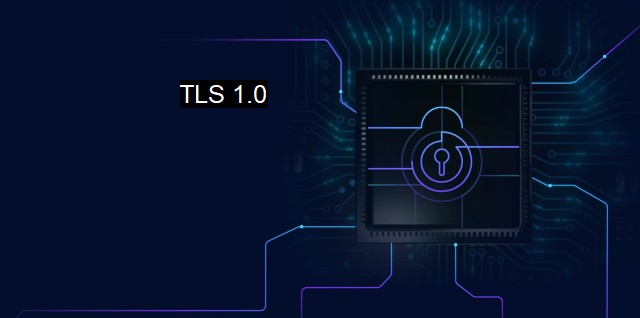What is TLS 1.0?
The Importance of TLS 1.0 in Internet Security and Cybersecurity: Risks, Vulnerabilities, and Solutions
Transport Layer Security (TLS) version 1.0 is a cryptographic protocol that provides secure communications across networks, particularly the internet. In cybersecurity contexts, it's responsible for safeguarding privacy and data integrity between two communicating applications. In various realms encompassing financial transactions, emails, and other confidential data exchanges, TLS 1.0 has played a pivotal role.This protocol was first standardised in January 1999 as the successor to Secure Sockets Layer (SSL) version 3.0, pronounced imperfect due to a series of security vulnerabilities. TLS 1.0 was the first version of the protocol that was developed under the name Transport Layer Security, seeking to better the shortcomings evidenced in the preceding SSL version. While serving similar purposes, there are key structural differences between SSL 3.0 and TLS 1.0.
TLS 1.0 features two layers: the TLS Record and the TLS Handshake. The TLS Record Protocol gives a secure connection that is superior to SSL by providing confidentiality and integrity measures for information. It divides data into smaller manageable blocks, compresses the data for transmission and attaches a unique Message Authentication Code (MAC). The TLS Handshake Protocol facilitates the secure exchange by authenticating both the client and the server and allowing the negotiation of an encryption algorithm and cryptographic keys before the application protocol can transit data.
As with all technologies, TLS 1.0 had its weak points that adversaries attempted to exploit, making cybersecurity practitioners question its abilities. Although TLS 1.0 was endowed with the mechanisms to provide a requisite degree of security and privacy, it strongly depended on the accompanying strategies of implementation. Thus, correct configurations, preventative antivirus measures, and security conscious design were key to leveraging TLS 1.0 with optimal efficacy.
Over time, modernised versions of TLS such as TLS 1.2 and TLS 1.3 were developed to cover the vulnerabilities of the previous versions and heighten the degree of security. The myriad of security risks associated with TLS 1.0 –from both theoretical and practical perspectives– ultimately led to its deprecation most recently in 2020. The Payment Card Industry (PCI) stopped recognising TLS 1.0 as a valid secure protocol, and browser companies and service providers also began to deny it systematically to eradicate possibilities of insecurity. ISO/IEC 27001:2013 and GDPR likewise require companies to desist in using deprecated and insecure protocols, thereby limiting its practical applications, contributing further to its deprecation.
Post-deprecation, protective measures such as antivirus software have seen a widening scope of activeness and responsiveness. Antivirus systems are developed around algorithms that spot suspicious or known-to-be-risky patterns. Given the recurring exploit of TLS 1.0 vulnerabilities, coded behaviours aiming to exploit it would likely opalesce patterns met with strong rejections from up-to-date cybersecurity products. Continuing to enforce TLS 1.0 would contrarily be incompatible with robust cybersecurity practices.
TLS 1.0 incepted as the follow-up to SSL 3.0 achieved its foundational objective of amplifying the provisions for secure internet communications. Its susceptibility to potential exploitation necessitated repeated reviews, tweaks, and eventually a series of successors, each bringing better, tighter cybersecurity protocols into established use. Consequently, this left TLS 1.0 not only redundant in its functionality but flawed compared to its successors. For the very fundamentals of privacy and integrity that it was meant to protect—fallible standing situations of potential exploit—it stands excluded from credible cybersecurity measures today, including antivirus systems.

TLS 1.0 FAQs
What is TLS 1.0?
TLS 1.0 (Transport Layer Security version 1.0) is a security protocol used to encrypt communication between two devices over the internet. It is widely used for securing online transactions and sensitive data such as login credentials, credit card information, and personal health information.Why is TLS 1.0 considered insecure?
TLS 1.0 is considered insecure because it has known vulnerabilities that can be exploited by cybercriminals. These vulnerabilities allow attackers to intercept and decrypt secure communication, steal sensitive information, and launch other types of cyber attacks.Should I still use TLS 1.0 on my website?
No, you should not use TLS 1.0 on your website as it poses a significant security risk. Most modern browsers and operating systems have stopped supporting TLS 1.0, and using it can leave your website vulnerable to cyber attacks. It is recommended that you use the latest version of TLS (currently TLS 1.3) or at least TLS 1.2 to ensure maximum security.Can antivirus software protect against TLS 1.0 vulnerabilities?
Antivirus software cannot protect against TLS 1.0 vulnerabilities directly. However, antivirus software can help protect against malware and other types of cyber attacks that exploit these vulnerabilities. It is still important to upgrade to a newer version of TLS to ensure maximum security.| | A | | | B | | | C | | | D | | | E | | | F | | | G | | | H | | | I | | | J | | | K | | | L | | | M | |
| | N | | | O | | | P | | | Q | | | R | | | S | | | T | | | U | | | V | | | W | | | X | | | Y | | | Z | |
| | 1 | | | 2 | | | 3 | | | 4 | | | 7 | | | 8 | | |||||||